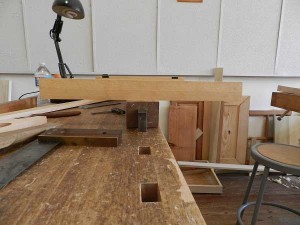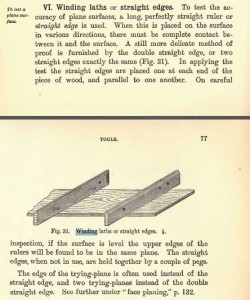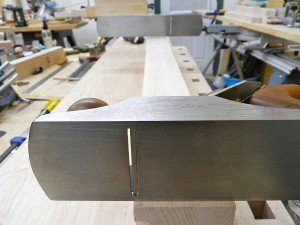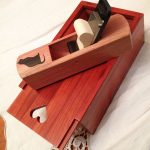We may receive a commission when you use our affiliate links. However, this does not impact our recommendations.
A good pair of winding laths or winding sticks is sometimes hard to find – I suspect not many have survived the burn pile. The good news is that a new set is easily made in a few minutes at the bench.

Sighting down a board with winding sticks. This set was made by my friend Bill Anderson of Edwards Mountain Woodworking.
Why would I want a pair of ‘Winding Sticks’? What do they do?
- This pair of matching straightedges is a fast and invaluable tool that allows you to quickly see if a board is flat.
- By placing them at each end of a board, sighting across the near stick and looking at the far one, you can more easily see any twisting or warping in the board. The sticks help accentuate any non-planar surfaces.
- By moving one stick and sighting the board at a few locations along its length, you will quickly see how the board flows.
- Using a single stick you can also check for any cupping or warping as you would with any other straightedge.
- Once you identify parts of the board that need to be addressed, you can quickly plane them and re-evaluate the board using these sticks. (After a bit of practice, the process goes quite fast.)

Winding lath by Otto Salomon in the ‘Teacher’s Handbook of Sloyd’ — a great prototype for your own winding sticks
From Otto Salomon’s “Teacher’s Handbook of Sloyd” (above) you can read a nice description for how to use winding laths efficiently. The pair of wooden Sloyd winding laths shown in the picture nest with each other via a set of fitted wooden pins and have a nice relief one edge so you can easily get a finger hold in there and separate the sticks when you want to use them. Salomon also calls out an interesting alternative you can use in a pinch – by turning two handplanes on their sides you can use them as an impromptu set of winding sticks and sight across them.

Two hours of expert instruction from Bill Rainford on hand drafting. Click the picture to learn more about what’s covered and watch an excerpted video.
Tips on making your own winding sticks:
- Use quarter-sawn hardwood like hard maple or beech
- Consider adding a contrasting inlay or strip to make it easier to sight across the sticks
- I like to use sticks that are 1/2″ thick, about 2″ wide and about 18-24″ long
- Sticks that can nest with each other or otherwise stay together are more likely to survive
- Taper each stick on one side so that it’s clear which edge is the top (it will not stand on its own on the edge you plane down to 1/8″)
- If your sticks ever get out of true you can easily square them up again with a plane
The next time you are out in the shop, make a quick set of winding sticks and see how much it can improve your board flattening efficiency.
Here are some supplies and tools we find essential in our everyday work around the shop. We may receive a commission from sales referred by our links; however, we have carefully selected these products for their usefulness and quality.










If you paint one winding stick white and the other black the contrast will make them easier to use and also prevent them from ending up in the burn pile. Who burns good scrap wood??
Thanks for the explanation